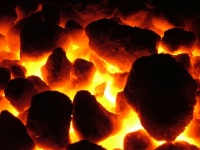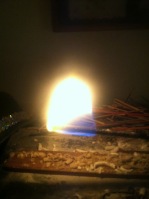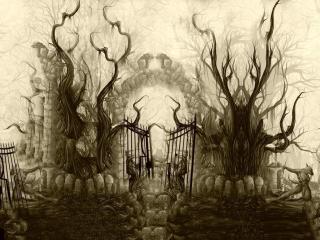I’ve been thinking of Witch as Smith. He (using male pronouns here but “she” is equally true and brings us to Brigid or Athena rather than Weyland or Hephaestus) is truly the master of all four classical elements (ignoring Spirit or Ether here, but if included, this would be the Smith himself). Earth is the hammer and anvil, and the metal he works, but more elementally, earth is used in the annealing process to cool slowly verses water’s fast cooling. Air is the bellows, heating the fire hotter. Fire is the heat, the shaper and temperer. Water is the cooler and quencher, causing hardening.
The process of smithing shows a lot of things about the Smith and about the weapons and tools he makes. It’s interesting to see Witch as the Warrior (Hercules) that uses the weapons (Kornephoros, the Club Bearer) the Smith forges, the Hunter (Orion) using the weapons (ensis, the Sword, consisting of Theta Orionis C, Hatsya, and the Great Orion Nebula, and the Club, consisting on Betelgeuse [Orion’s hand], Nu Orionis, Xi Orionis, Chi1 Orionis, and Chi2 Orionis) to hunt, and also the Ploughman (Bootes) using the plough (Ursa Major, the Big Bear, also called the Big Dipper, but in this context, the Plough pushed by Bootes). Orion is significant to me this time around, because of an encounter during my recent bone rite, which I won’t discuss here. Bootes, the Ploughman, is significant, as several British traditions see him as Cain, who holds much significance in their mythos. And Hercules is significant since a large portion of the constellations we have today are based on the myths relating to him.
So, what is a smith? The English word smith comes from the Old English smið, meaning, not surprisingly, “one who works in metal”. This comes from the reconstructed Proto Germanic *smithaz, “skilled worker”, from the reconstructed Proto Indo European *smei-, “to carve, cut”. So we could say a smith is one who carves or cuts to make something. A stonemason could be called a stonesmith. One who works with the Threads of Fate could be called a wyrdsmith or weirdsmith or fatesmith. This is Witch. Tin is white metal, so a tinsmith is a whitesmith. Iron is black metal, so a ironsmith or steelsmith is a blacksmith.
Looking primarily with iron and steel smithing, blacksmithing, though much applies to other metals, here’s a basic discussion of the stops. A bit simplified, and written by myself who has never done any smithing, so don’t use it as a guide. This summary is for discussion sake.
First you take the iron or steel and heat it in fire and coals, using the bellows (Air) to raise the heat until the metal glows bright red. Then you hammer the metal into the needed shape with the hammer on the anvil, heating it again periodically when it cools. This is forging.
Next you anneal it, a process that decreases ductility, the compression of the metal under stress, and increase hardness, by aligning the metal. This is done by burying the hot item in soil, in earth, until it cools slowly and naturally to a temperature that’s cool to the touch. This is repeated several times, heating the metal in a lower temperature fire than the forging process.
Third, you sharpen it if needed (some weapons and tools need sharpening, some don’t), on a whetstone or file, or some other controlled grinding tool.
Once sharpening is done, it’s time to demagnetize the item. This keeps the filings from sharpening from sticking to the item, allowing the unneeded pieces to fall away instead of staying part of the item. This is done by repeatedly heating the metal to an orange colour, then slowly heating it above red until a magnet won’t stick to it.
The fifth part is quenching. This is in water, oil, or brine, all Water for out purposes. The item is quickly doused into the Water, cooling it rapidly. It is left in the Water until it completely cools, resulting in through-hardening.
Next is tempering. This is done by heating the item from the spine (the part away from the edge, the thickest part) until the spine glows yellow (so not as hot as the orange and a long way from the red). This makes the item more flexible, so less brittle and less chance of it breaking.
Next you mount it if you need a handle or other wooden control piece. This is typically done by heating the tang, the part the handle fits on, and using it to burn the hole needed into the wood.
The final step is polishing. While this might seem needed for, say, a ploughhead, the purpose isn’t purely ascetics. This is the process of working out the imperfections and textures of the metal. A rough plough will have more resistance in the soil and be harder to clean. Basically, this is just sanding off the roughness, starting with course sandpaper or stone and working to finer and finer to make it as smooth as possible.
Let’s look specifically at several of the Smith’s tools. Of note are the hammer and anvil, the forge and bellows, the whetstone and tongs, and the quencher and mound. There are a number of other tools, and some of these are more representative than actual. But they help in the current discussion.
And hammer and anvil tend to be the symbol most used for smithing. Who doesn’t think of them when they think of a smith? The large man standing with a hammer in his hand, the metal on the anvil, striking it over and over. The words of the English folksong, “Blacksmith”, call out in the voice of Steeleye Span:
A blacksmith courted me
Nine months and better
He fairly won my heart
Wrote me a letter.
With his hammer in his hand
He looked so clever
And if I was with my love
I would live forever.
In practice, while that image does hold, it’s simplistic. First off, it was common to have a striker, who was an assistant, often an apprentice, who swung the sledge hammer when it was needed. The smith, the master, would hold the metal in the tongs and direct the striker where it hit. In addition to the sledge hammer, there were smaller hammers, which is where the image described above comes from. There were often several for different jobs, and these were used along with many punches, used to create holes, chisels, used to chip at the metal, and other tools called swages, used to shape the metal. There is also a hammer called a fuller or a creaser, a rounded hammer used to create grooves and to spread the metal.
An anvil is basically just a large, hard block of iron, tempered to handle the force of the shaping done against it. It was primarily used during the forging process, when the metal is very hot and the force against it is hard. Once the shaping began, the swage block was used instead. A swage block is perforated and used for more fine work and finishing work.
Next we have the forge and the bellows, Fire and Air. These are the heating part of the process. The forge heats the metal, the bellows heat the fire, or more accurately, the bellows provide more oxygen to feed the fire of the forge, causing it to burn richer, and therefore hotter. The forge is the heart of the smithy, and the bellows are it’s lungs. Without the forge, you can’t smith. Without the bellows, the forge can’t be raised to the temperatures necessary for ironwork. Another related craft to smithing is casting. His also uses a forge, but requires much hotter temperatures, because instead of softening the iron or steel (or other metal), you need to completely melt it to pour it into a cast, giving its shape through fluid pouring then cooling instead of my solid pressure from the hammer.
The whetstone and the tongs aren’t related in the way the hammer and anvil, and forge and bellows are, but they are two tools that are distinct from the others.
The tongs, obviously, are used to hold the hot metal. You can’t reach into the forge and pull out the metal with your hands, nor can you hold it in place when it’s being hammered and worked while hot with your hands. The tongs serve as an extension of your hand, fireproof and stable.
I use whetstone here to represent several different types of tools. Not all smithies contain the same assortment, and different types of work require different assortments. All are used for grinding and sharpening. They are course, to different degrees, and all are used to remove, not to shape. Shaping implies changing of what’s there into a different form. These tools remove excess to give a new form. Chisels could be placed here as well by that description, but there’s another characteristic of these tools: friction. They are used to remove through rubbing, not chipping. These tools include the literal whetstone, which is a piece of actual stone that’s harder than iron and rough in texture, files, which are rough metal tools for grinding, sandpaper, which is paper with some type of grit on it to wear off the metal, and grinding machines, basically a stone wheel turned by a mechanism similar to a mill stone, which the metal is held against to grind.
Finally, the mound and the quencher, Earth and Water. As the forge and bellows heat, the mound and quencher cool.
Mound I’m using symbolically; there isn’t a mound of earth in most smithies. I’m referring to process of burying the item to slow cool it in the anneal process. Sometimes the heating during the anneal process is done in a separate fire outside the forge, then the whole fire buried in earth, other times, the forge or a secondary forge is used to heat it without using the bellows to raise the temperature, then the item is buried in a pit, or sometimes an actual mound.
The quencher is a barrel or trough or similar container filled with the oil or brine or water, used for, obviously, quenching. The difference in fluid is due to the boiling points needed to effectively cool the metal quickly. If the boiling point is too high, the metal will cool too quickly and likely crack. Water has the lowest boiling point, so cools faster as the heat vaporizes it. It is sometimes used for iron, but sometimes cools too fast. When it does, brine is often used. Brine is in effect salt water. Adding the salt raises the boiling point. Steel requires slower cooling than iron, so often requires oil, which has a much higher boiling point than water or brine. For “oil” this varies from vegetable or animal fat oil to petroleum based fluids like transmission fluid or petroleum oil. Of course, in the days before wide spread petroleum availability, plant or animal oils were primarily used.
Now that we’ve looked at the tools, let’s look at the process from an esoteric viewpoint. Here’s the steps outlined above:
1) Forging
2) Annealing
3) Sharpening
4) Demagnetizing
5) Quenching
6) Tempering
7) Mounting
8) Polishing
Forging, as discussed, is the process of softening the metal and shaping it with tools. It is fire of the forge, air of the bellows, and earth of the hammers, tongs, anvils, and related tools. Fire, air, and earth. Softening and shaping. Think about these in your life. What heats things up? How does it soften you, making you malleable so you can be shaped? What shapes you? In what ways? In the military, this is Basic Training, the initial training that shapes you into a soldier. Looking deeper, think of the mysteries. What stage is this? This is the teaching phase, the prep work, the daily practice, the period of observation and learning. It is the time of the student and teacher, the period where you get a taste of the tradition and that taste changes you. This is Gwion stirring the Cauldron of Ceridwen and finally getting a drop in his mouth. It is a time of hard work, of sweat and tears.
Annealing, that which makes the metal ductible, and hence unable (or as close as possible) to break under pressure. This is the process after it is the right shape to avoid it losing that shape. The setting of it in that shape. This is, as stated, the process of burying to cool, heating, cooling, and so on. Earth to cool, fire to heat. Earth and fire. Making ductible. Think about this in your life. The process of shaping you creates rapidity, afterward, you have to be made to handle pressure or you will crack. You see this in the military, where the initial training hardens you and sets you in a certain shape. Following that, the soldier responds by muscle memory and reflex, which is often necessary, but makes it harder to make a decision outside the training when needed. The period afterwards requires adapting that training to an active process, if the soldier is to become an officer or any type of leader. Otherwise, you will crack under pressure, because once you reach the end of what you were trained for, you have nothing left. Looking deeper, think of the mysteries. What stage is this? Often the later period of training is different from the first, a period of testing where the teacher analyzes if the student is ready. During this time, you are made to be able to handle the pressure that will come later. In the tale of Taliesin, this is the period after Gwion drinks the drop. Ceridwen is chasing him, trying to kill him. He must change and adapt or die. This is shown in the shapeshifting contest, Gwion changing into forms to get away, and Ceridwen changing into forms to catch him.
Sharpening, the grinding stone, where anything not needed is stripped away. This is earth and only earth. Forging starts with fire, air, and earth, air is removed for annealing, now fire is removed. Earth. Removing. Think about this in your life. Once you are able to handle pressure, unneeded things can be stripped away. Before, the lose of them might break you. In the military, this is your first battle or series of battles. Once in the fight, your shape (training) and ductibility (ability to adapt) are tested and anything unneeded is stripped away. At this point, either the the training and ability to adapt serve you well, or you die. Looking deeper, think of the mysteries. What stage is this? This is initiation, in whatever form it takes. In a very real way, that which isn’t needed is stripped away in death, and what is needed emerges from the other side. In the tale of Taliesin, this is Gwion becoming a grain, and Ceridwen into a hen and eating him.
Demagnetising, the reforming and realigning of the metal so it won’t hold onto what was removed in sharpening. This is done with fire and only fire. The metal is heated, let to cool some, heated, let to cool some, and so on. Fire. Letting go of what was removed. Think about this in your life. After the unnecessary things are removed, how hard is it to really let go of them? What has to happen to really move on? I’ll leave the soldier analogy behind at this point, as, never having been a soldier, I’m not sure how these steps apply at this point onward. Digging deeper, think about the mysteries. What stage is this? After initiation, in the period following, many people feel lost, because they haven’t let go of what was removed, but haven’t come to terms with the changes that occurred. It’s a transitory time, a birthing you could say, with initiation being the time of conception. And this parallels Taliesin’s tale. Ceridwen is pregnant after eating the grain, and gives birth to Taliesin nine months later, Gwion reborn.
Quenching, the hardening process, by which the metal is made to be strong enough to hold off any impact (or as close as possible). This is a water only process, if you view water, brine, and oil all as water, which they have the characteristics of. Water. Hardening. Think about this in your own life. The point following the final letting go of the things you’ve lost tends to be an emotionally null time, a quenching of your emotions, a hardening of your spirit. This is necessary to hold onto what is needed after losing what is not. “What have, I hold!” as Cochrane would say. Which leads us into the mysteries. What phase is this? After we’ve come to terms with the changes, we have to apply them. This requires determination and persistence, and force of will. A quenching of our desire, so we can do what’s necessary. Not a period that lasts forever, but a necessary period. In the tale of Taliesin, this is Ceridwen, who had intended to kill him when he was born, tying him in a bag and setting him adrift in the sea. his period, floating on the sea, was a time of hardening, and directly visible as being quenched in water, since he was put in the sea.
Tempering, heating the blade once more to make it flexible. This once again is fire only, but a lighter, milder fire, not heating as hot. Fire. Flexibility. How does this apply to your life? Hardening after loss tends to lead to rigidity, and while necessary for a time, this is bad in the long term. Once that phase has passed, you need to regain flexibility so you can weather any future trouble. Your heart has cooled in hardness, now it’s time to warm it back up, not to the point of forging, but from where it is. Looking deeper, how does this apply to the mysteries? What phase is this? That initial digging in and hardening must be followed by a more flexible time. Hardening applies what you learn, growing flexible makes it yours, adapts it to you. It’s a period of renewed growth. Growth doesn’t end with initiation. In Taliesin’s tale, this is the period following him being found among the salmon as a child, during which he grew up.
Following tempering, is mounting, the putting of a handle or hilt on the metal. This is often done, once more, with fire alone. Fire. Mounting. How does this apply to your life? A tool can’t be used without a way to hold it or attach it. The same is true of our lives. There is always a bit more pain before we are ready for what is to come. This is preparation. Digging a bit deeper, how does this apply to the mysteries? What phase does this represent? In the Eleusinian Mysteries, this is the Greater Mysteries. The initiate, after passing through the Lesser Mysteries which were initiation, then can enter the Greater Mysteries, a second initiation in some way, yet different from the first. This is preparation for the real work, the first initiation and the period between the preparation for this. This holds true for other types of initiation as well. Initiation prepares you for the rest of the process, but there comes a time of change that prepares you for the actual work. In the tale of Taliesin, this is his exploits in court, where he has to outsmart the others involved to save what is dear to him.
The final phase is polishing. The metal at this point is perfectly formed, shaped, ductible, flexible, and strong, but it’s rough. The imperfections are removed by polishing it, giving it’s final look. This is a process of only earth, and is fine and careful work, persistence without a heavy hand. How does this apply to your life? The only thing left after you are prepared for what will follow a time of loss to to smooth out the rough edges so you don’t get stuck on things that might hold you back. The same is true in the mysteries. The last stage is the years of polishing all your imperfections out, so you don’t get caught up on things that might hold you back from the great work. For Taliesin, this is his travels as a bard after the tale is done. He’s doing the work everything before has prepared him for, polishing his skills as he goes.
And so it goes, as with the Smith, so with the Witch, as with the craft, so with the Craft. For, the Craft is the Craft of all Crafts.
FFF,
~Muninn’s Kiss






















